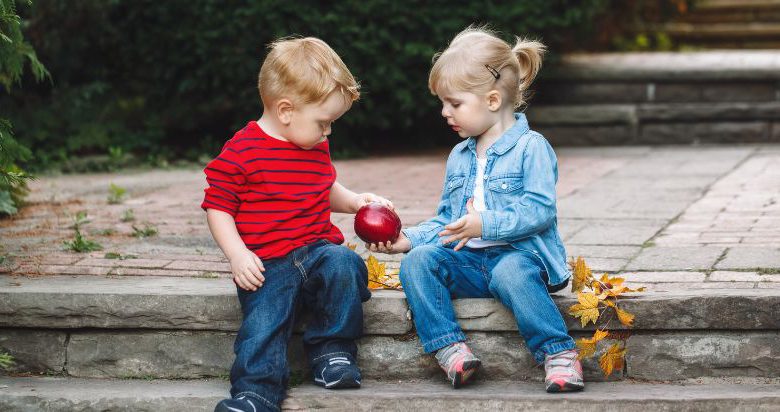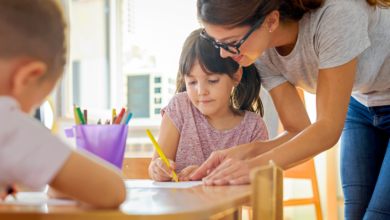How to Teach Kindness and Empathy to Young Children

How to Teach Kindness and Empathy to Young Children
We’ve all been there – your child guarding their toys or shouting ‘mine!’ around others. When a child is protecting their toys it’s typically a signal that they’re still learning to share and understand empathy. So, why do kids seem so, well, self-focused? And how can you nurture kindness and empathy in your children to help them grow into compassionate, caring people?
It turns out, the “self-centered” behavior we see in toddlers and preschoolers isn’t just a phase—it’s an important part of early childhood development. Understanding the reasons behind these behaviors can help you approach teaching empathy and kindness with patience, insight, and a dash of humor. Let’s dive into what makes young children “me-focused,” why it’s totally normal, and the ways you can lovingly guide your children to grow big, empathetic hearts.
Why Are Young Children Naturally Self-Centered?
Understanding empathy starts with biology and brain development. For young children, the world feels like a swirl of new experiences, and their brains are hard at work just trying to process it all. According to research published by the CellPress journal, here’s why children are often focused on themselves:
- The Developing Brain
In the first few years, a child’s brain is rapidly growing, but parts responsible for complex emotions like empathy are still under construction. The prefrontal cortex, which helps us think through others’ perspectives, is in its infancy during early childhood. So, while kids may understand that others have feelings, connecting those feelings to their own actions takes more time. - The Age of Egocentrism
Developmentally, young children go through what psychologists call an “egocentric” phase, where they see the world primarily from their perspective. They’re not being selfish intentionally; they simply haven’t reached the cognitive stage where they can fully grasp another person’s point of view. For a three year old, it’s like they’re the star of their own movie, and everyone else is a supporting actor. - Self-Preservation and Survival
From a biological standpoint, a child’s instinct to protect their belongings and assert “mine!” reflects early survival mechanisms. While they’re not fighting for survival, this behavior is still part of building self-identity, asserting independence, and exploring boundaries.
Knowing these early childhood developmental milestones can help parents approach empathy-building with empathy of their own. Instead of expecting your children to behave with the empathy of an adult, you can gently guide them toward kindness in ways that match their understanding.
How to Encourage Empathy and Kindness (Even if it’s a Little Rocky at First)
Now that we know why young children don’t naturally share and empathize, let’s explore ways to nurture these qualities in ways that fit their developmental stage. After all, kindness is like any other skill—practice makes progress!
1. Be a Kindness Role Model
Children are incredibly observant. They notice how you interact with others, and they look to you for guidance on how to act in the world. Model kindness and empathy in your own actions, whether it’s being polite to others, speaking kindly about people, or showing compassion to someone in need.
- Tips for Modeling Kindness:
Make a habit of verbalizing empathetic actions in front of your child. For instance, “I’m going to bring soup to Mrs. Smith because she’s not feeling well. Helping friends feels good!” These explanations show your child that kindness is a natural response to someone else’s situation. - Use Everyday Examples:
When you see kindness in action—like someone holding the door open or helping carry groceries—point it out to your child. Hearing “Did you see how that person helped?” reinforces the value of kindness in a way children can understand.
2. Encourage Empathetic Language
Empathy often begins with understanding and naming feelings, both your own and those of others. By teaching your child to identify and discuss feelings, you’re building the foundation for empathy.
- The Power of Emotion Words:
Teaching words like “happy,” “sad,” “frustrated,” or “excited” gives children the language to express their feelings and recognize emotions in others. This helps them connect with others emotionally, which is the essence of empathy. - Using Books and Stories:
Stories are a wonderful way to explore feelings and discuss characters’ motivations. When reading with your child, pause occasionally to ask questions like, “How do you think she feels right now?” or “Why do you think he did that?” It’s an engaging way to introduce empathy while building literacy skills.
3. Practice the Art of Sharing
Teaching your children to share can feel like climbing a mountain, but don’t worry; patience and consistency are key. Start small, and remember that sharing is a skill that gets easier with practice.
- The Power of Taking Turns:
Instead of framing it as “sharing,” try using “taking turns.” This keeps it simple and manageable. When they’re done, they know their turn is up, and the other child gets a chance. - Celebrate Small Wins:
When your child does manage to share (even if it’s just once!), celebrate that moment. Positive reinforcement like “I saw you let Max use the crayons—what a nice thing to do!” helps reinforce that sharing feels good.
4. Teach Them to Recognize Other Perspectives
Because young children see the world from their viewpoint, guiding them to understand another person’s perspective takes gentle, ongoing effort. But the results are worth it, as they begin to realize the world is a community with feelings as varied as their own.
- The “How Would You Feel?” Technique:
When conflicts arise, ask questions like, “How would you feel if someone took your toy?” This gives them a chance to pause and imagine themselves in someone else’s shoes. - Engage in Imaginative Play:
Imaginative play, like pretending to be a doctor, teacher, or friend, allows children to “try on” different roles. Through role-playing, they practice empathy and begin to understand that other people have different needs and feelings.
5. Encourage Kind Acts (and Make It Fun)
Kindness can be encouraged as a fun activity rather than a lesson. You can do small acts together that reinforce the joy of helping others, while letting children choose ways to show kindness on their terms.
- Create a Kindness Chart:
Set up a chart where your child can “earn” stars or stickers for kind acts, like helping a sibling or sharing with a friend. At the end of each week, celebrate their kindness by talking about how each act helped someone else. - Do Kindness Challenges:
Each week, set a “kindness goal,” like giving a compliment or drawing a picture for someone. These mini-missions give your child a purpose and reinforce how fun it is to be thoughtful.
6. Guide Them Through Conflict Resolution
Conflict resolution is an empathy-builder in disguise. When children have disagreements, helping them work through it gives them the tools to understand others’ feelings, express themselves kindly, and reach a compromise.
- Use “I” Statements:
Teach your children to use “I” statements, like “I feel upset when you take my toy,” instead of “You always take my things!” This approach keeps communication open and respectful. - Ask Questions Instead of Solving Problems:
Resist the urge to jump in with solutions, and instead ask, “What do you think you could do to help your friend feel better?” You will be amazed by the creative solutions your child can come up with.
7. Practice Patience—Empathy Takes Time
Learning kindness and empathy isn’t a quick process. As much as we wish we could fast-track this growth, it takes patience, modeling, and little nudges over time. Celebrate every small step toward kindness, and remember that with your steady guidance, your child’s empathy skills will grow beautifully.
- Celebrate Empathy “Milestones”:
Just like we celebrate a child’s first words or steps, celebrate their empathy milestones. When they show compassion or think of others’ feelings, mark it with a hug, high-five, or verbal praise. - Reinforce Empathy as a “Family Value”:
Incorporate empathy into family routines by talking about kindness daily. Whether it’s at the dinner table or before bed, share one kind thing each family member did that day.
Growing Empathy, One Kindness at a Time
Encouraging kindness and empathy in young children may require more than a little patience, but it’s one of the greatest gifts you can give them—and the world. With guidance, a bit of practice, and lots of small teaching moments, they’ll develop the skills that make a kind-hearted adult.
So, the next time you see your child sharing a toy, saying something kind, or recognizing another child’s feelings, take a moment to celebrate it. Every act of empathy and kindness, no matter how small, is a seed that will blossom into something truly wonderful. And, as you know, with empathy, a little goes a long way.
Teaching kindness is a journey, one that will not only enrich their lives but brighten the lives of everyone they touch along the way.
If you found this week’s blog helpful, you will want to add these to your reading list!
- Why do Kids Tattle?
- Helping Children Understand Forgiveness
- How to Teach Social Skills to Your Preschoolers





